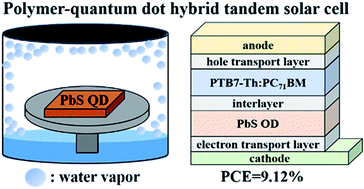Promotion of performances of quantum dot solar cell and its tandem solar cell with low bandgap polymer (PTB7-Th):PC71BM by water vapor treatment on quantum dot layer on its surface†
Abstract
In this study, we propose new treatments on the PbS quantum dot (QD) layer surface by exposing it to air, water vapor and oxygen environments at room temperature. For air, water vapor and oxygen treatments, the lead oxides PbSO3, and PbSO4 are formed at the surface, while for air and oxygen treatments, PbO is additionally formed. These oxides are able to prevent charge recombination between PbS QDs, which results in higher open circuit voltage (VOC) and fill factor (FF) than those without treatment. The absence of lower conductivity oxide PbO in the water vapor treatment leads to short circuit current density (JSC) higher than those of air and oxygen treatments. In the hybrid tandem solar cell with PTB7-Th:PC71BM as the top cell and PbS QD as the bottom cell, the water vapor treatment leads to a PCE of 9.12%, which is higher than that without treatment (7.37%), with air treatment (8.70%) and oxygen treatment (8.47%). The PCE 9.12% is the new record PCE among the reported polymer QD hybrid tandem solar cells.



 Please wait while we load your content...
Please wait while we load your content...